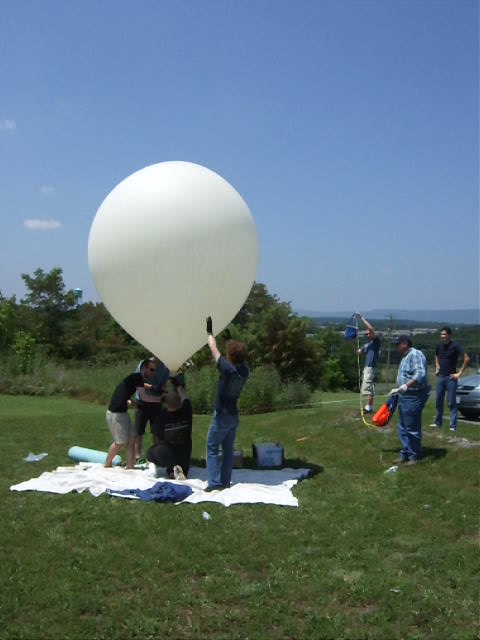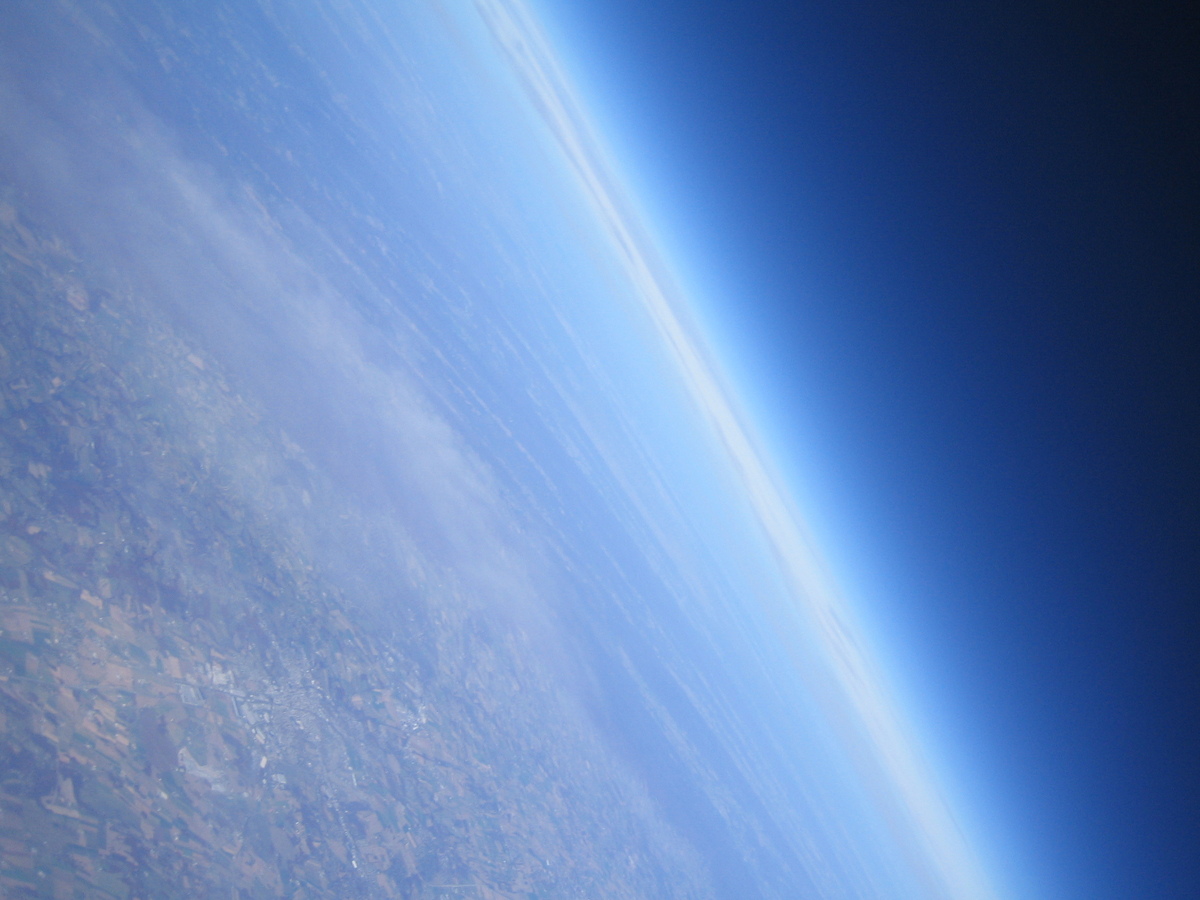HacDC Spaceblimp: Difference between revisions
From HacDC Wiki
| (90 intermediate revisions by 22 users not shown) | |||
| Line 1: | Line 1: | ||
[[ | [[Image: sb5_launch_still.jpg | 300 px]] [[Image: sb3_IMG_6899_small.jpg | 530 px]] | ||
A collection of stuff about HacDC's near space initiatives, including the ''Hackerspaces In Space'' Contest entry (2010). | A collection of stuff about HacDC's near space initiatives, including the ''Hackerspaces In Space'' Contest entry (2010). | ||
=Current Status= | |||
Project Spaceblimp is back! Spaceblimp has been a multi-discipline club effort to build, launch, track, and recover a [https://en.wikipedia.org/wiki/High-altitude_balloon High-altitude Balloon]. So far HacDC has launched [[Template:Spaceblimp|6 Spaceblimps]], with [[HacDC_Spaceblimp_5|Spaceblimp 5]] reaching a maximum altitude of 118,533 ft and [[HacDC_Spaceblimp_6|Spaceblimp 6]] reaching 104,023 ft on 15 October 2016. The next iteration is expected in Spring 2018. | |||
= Come be involved in [[HacDC Spaceblimp 6|Spaceblimp 6]] = | |||
Balloon | Since Global Space Balloon Challenge 2016 (GSBC) just ended, there is no better time than now to start planning for participation in, but not limited to, the GSBC 2017 challenge. HacDC has had some preliminary discussions with the Naval Research Laboratory (NRL) regarding some of their STEM initiatives which align well with our Spaceblimp project. This presents a great opportunity for HacDC to collaborate with the NRL and local area schools to assist students in preparing for the next GSBC or other balloon events. Besides helping young minds grow, we could also expand in to other STEAM initiatives and work side-by-side with distinguished researchers and scientists from the NRL. | ||
Supplies and equipment are not an issue. Hands on help is. We need embedded hardware, software, FPGA, and RF engineers, licensed amateur radio operators, project developers, crafts people, decorators, coordinators, outreach specialists and educators. However, no one with helping hands or a willingness to learn will be turned away. | |||
=History of the HacDC Spaceblimp Project= | |||
* On Aug 7, 2010, we launched our first balloon: [[HacDC Spaceblimp 1]]. Its epic journey began well enough, but the antenna came loose somewhere around 60,000 ft and we never heard from it again. Until three months later, when a farmer found it in her field, called up a friend (who happened to be an engineer) and it came back home. The pictures are fantastic, but the telemetry data was lost -- it overwrote itself many times over before the batteries finally gave up. | |||
* Following (what we thought was) the loss of Spaceblimp-1, we scrambled and launched [[HacDC Spaceblimp 2]] on Aug 21. It went flawlessly -- fast, light, and with good radio contact the whole way through. It may be the third fastest-ascending amateur radio balloon. We were disqualified from the Hackerspaces in Space competition because we went over budget, but they said we would have come in fourth if not. Sigh. But again, it was an inspiring success. | |||
' | * [[HacDC Spaceblimp 3]] was successfully launched and retrieved on 13 Nov 2010 with a much more involved payload than previous versions. More cameras, HD video, more radios, an accelerometer, geiger counter, pressure sensor. Weight and price weren't constraints this time. | ||
* [[HacDC Spaceblimp 4]] set the HacDC altitude record, topping out at 103,764 ft! This flight got fantastic video -- make sure to check out the two youtube links. | |||
* Insatiable and unstoppable, the HacDC team puts up [[HacDC Spaceblimp 5]] on July 9, 2011. We bought a yet-bigger balloon to try to get higher, and so: 118,533 ft! | |||
* [[HacDC Spaceblimp 6]] was launched in October 2016, reaching 104,023 ft with HD video, instrumentation and various GPS radio trackers. It was the first Spaceblimp that captured video of its own balloon and parachute. It was recovered in record time just 20 minutes after landing despite failure of its primary radio transmitter (the backup worked!) and the video is now on YouTube. | |||
* [[HacDC Spaceblimp 7]] is planned for late March 2018 with various GoPro HD cameras, a new TrackSoar GPS/Radio tracker, three Raspberry Pi Zeros and a gyroscopic stabilizer. | |||
* '''If you want to get involved or learn more or contribute to the program...[http://hacdc.org/mailman/listinfo/spaceblimp Subscribe to the Spaceblimp email list]''' | |||
=Related Links= | |||
* [http://www.flickr.com/groups/spaceblimp/ HacDC Spaceblimp Flickr Group] | |||
* [https://www.flickr.com/photos/itechgeek/collections/72157627971098680/ All HacDC Spaceblimp photos (hosted on ITechGeek's Flickr)] | |||
GPS visualizations of balloon trajectory from the Flickr Group (made with GPS Visualizer http://www.gpsvisualizer.com/): | |||
[http://www.flickr.com/photos/79273063@N00/4946912327/ Google Earth GPS trajectory visualization] and | |||
[http://www.flickr.com/photos/79273063@N00/4947501800/ Google Maps GPS trajectory visualization] | |||
<noinclude> | |||
{{Template:Spaceblimp}} | |||
</noinclude> | |||
Latest revision as of 00:27, 8 March 2018
A collection of stuff about HacDC's near space initiatives, including the Hackerspaces In Space Contest entry (2010).
Current Status
Project Spaceblimp is back! Spaceblimp has been a multi-discipline club effort to build, launch, track, and recover a High-altitude Balloon. So far HacDC has launched 6 Spaceblimps, with Spaceblimp 5 reaching a maximum altitude of 118,533 ft and Spaceblimp 6 reaching 104,023 ft on 15 October 2016. The next iteration is expected in Spring 2018.
Come be involved in Spaceblimp 6
Since Global Space Balloon Challenge 2016 (GSBC) just ended, there is no better time than now to start planning for participation in, but not limited to, the GSBC 2017 challenge. HacDC has had some preliminary discussions with the Naval Research Laboratory (NRL) regarding some of their STEM initiatives which align well with our Spaceblimp project. This presents a great opportunity for HacDC to collaborate with the NRL and local area schools to assist students in preparing for the next GSBC or other balloon events. Besides helping young minds grow, we could also expand in to other STEAM initiatives and work side-by-side with distinguished researchers and scientists from the NRL.
Supplies and equipment are not an issue. Hands on help is. We need embedded hardware, software, FPGA, and RF engineers, licensed amateur radio operators, project developers, crafts people, decorators, coordinators, outreach specialists and educators. However, no one with helping hands or a willingness to learn will be turned away.
History of the HacDC Spaceblimp Project
- On Aug 7, 2010, we launched our first balloon: HacDC Spaceblimp 1. Its epic journey began well enough, but the antenna came loose somewhere around 60,000 ft and we never heard from it again. Until three months later, when a farmer found it in her field, called up a friend (who happened to be an engineer) and it came back home. The pictures are fantastic, but the telemetry data was lost -- it overwrote itself many times over before the batteries finally gave up.
- Following (what we thought was) the loss of Spaceblimp-1, we scrambled and launched HacDC Spaceblimp 2 on Aug 21. It went flawlessly -- fast, light, and with good radio contact the whole way through. It may be the third fastest-ascending amateur radio balloon. We were disqualified from the Hackerspaces in Space competition because we went over budget, but they said we would have come in fourth if not. Sigh. But again, it was an inspiring success.
- HacDC Spaceblimp 3 was successfully launched and retrieved on 13 Nov 2010 with a much more involved payload than previous versions. More cameras, HD video, more radios, an accelerometer, geiger counter, pressure sensor. Weight and price weren't constraints this time.
- HacDC Spaceblimp 4 set the HacDC altitude record, topping out at 103,764 ft! This flight got fantastic video -- make sure to check out the two youtube links.
- Insatiable and unstoppable, the HacDC team puts up HacDC Spaceblimp 5 on July 9, 2011. We bought a yet-bigger balloon to try to get higher, and so: 118,533 ft!
- HacDC Spaceblimp 6 was launched in October 2016, reaching 104,023 ft with HD video, instrumentation and various GPS radio trackers. It was the first Spaceblimp that captured video of its own balloon and parachute. It was recovered in record time just 20 minutes after landing despite failure of its primary radio transmitter (the backup worked!) and the video is now on YouTube.
- HacDC Spaceblimp 7 is planned for late March 2018 with various GoPro HD cameras, a new TrackSoar GPS/Radio tracker, three Raspberry Pi Zeros and a gyroscopic stabilizer.
- If you want to get involved or learn more or contribute to the program...Subscribe to the Spaceblimp email list
Related Links
GPS visualizations of balloon trajectory from the Flickr Group (made with GPS Visualizer http://www.gpsvisualizer.com/):
Google Earth GPS trajectory visualization and Google Maps GPS trajectory visualization
| [email protected] |
| Subscribe to the Spaceblimp email list |


